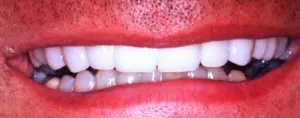
Crowns & Veneers
Dental Crowns & Caps
A dental crown fits over the entire top of the tooth above the gum line. Crowns cover, protect, seal and strengthen a tooth. A crown is needed when a filling just will not work. A crown may be made of white porcelain, or porcelain fused to gold alloy. There are many situations that may call for a crown:
- Deep decay. If a tooth has decay so deep and large that a filling will not stay, or if the tooth structure is weakened, a crown must be placed on the tooth to reinforce it.
- Large old fillings. When large old fillings break down, or get decay around them, they usually need to be crowned. It is important to crown a tooth that has been structurally weakened to prevent a cracked or broken tooth. Once a tooth breaks, it may not be possible to save it.
- Cracked tooth. When a tooth is cracked, a filling will not seal the crack. A crown has to be placed over the tooth to hold it together. If a crown is not placed on the tooth, the tooth will become sensitive to chewing pressure, or will eventually break. It is important to crown a cracked tooth before it breaks, because in some cases a broken tooth cannot be crowned and must be extracted.
- Broken / Fractured tooth. A tooth that has broken is usually too weak to hold a filling. A crown will hold the tooth together and prevent it from breaking again. If the fracture involves the nerve, Root Canal Therapy may be required before the tooth is crowned. In some cases, a broken tooth cannot be saved and must be extracted.
- Sensitive teeth. Teeth that are very sensitive, either from a lot of “wear”, or from receded gums, sometimes require crowns to seal and protect the teeth from hot and cold sensitivity.
- Root Canal Therapy. A tooth that has undergone Root Canal Therapy will need a crown to properly seal and protect the tooth. A tooth with Root Canal Therapy is more brittle than a tooth with a healthy nerve and blood supply. A crown provides the necessary support to the tooth.
For more information, please visit the CDA Website
In cosmetic dentistry, crowns (sometimes called “caps”) are used less frequently since the advent of veneers, but in some cases a crown may be necessary for a particular tooth. A tooth with a bad fracture or a large filling may be a candidate for a crown instead of a veneer.
Do you need an appointment or simply have a question?
Call now (514) 694-8150 or fill out our contact form.
Veneers
Veneers are custom, porcelain facings that are bonded to the front surfaces of teeth to whiten teeth, close spaces, straighten teeth, or repair chipped or worn teeth. The veneers are only about 1 mm thick (the thickness of a fingernail). That same thickness is “shaved” off the natural tooth surface so when the veneer is bonded to the tooth, the tooth doesn’t feel or look “thicker”.




For more information, please visit the CDA Website


